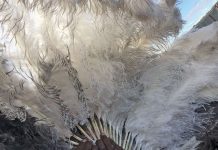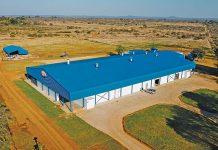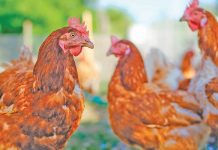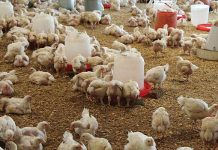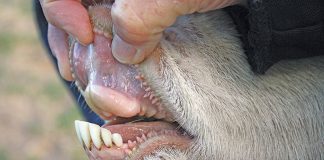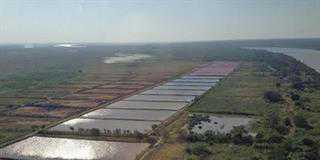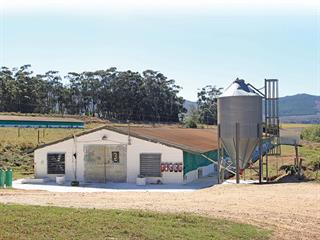
Temperature control is an essential part of successful broiler production, especially during the first two weeks of a chick’s life. Many producers in South Africa use liquid petroleum gas (LPG) to heat up their broiler houses, but Hugh Davison, who farms at Cordale Farms between Caledon and Hermanus, decided two years ago to use wood instead.
“Gas became so expensive that we ended up with a gas bill of more than R720 000 for our four chicken houses in 2012,” he recalls. “Gas supply also became erratic due to industry infrastructure problems. An alternative had to be found as heating is so critical to broiler production.”
In the search for alternatives, Davison experimented with electricity for a number of cycles, but found it expensive and increasingly unreliable due to load- shedding. Using chicken manure to create biogas was also not a viable solution, as the technology to use it efficiently to heat broiler houses did not exist at that stage. The production of biogas for heating broiler houses also requires intensive management and Davison was concerned that his attention would be diverted to gas production rather than his core chicken production.
“The ultimate system needed to be simple so that unschooled workers would be able to operate it,” he explains.
Alien removal
In recent years, there has been a strong drive to rid the area of invasive alien trees, and the Department of Environmental Affairs (DEA) is spending vast amounts on the task. Davison has been coordinating this clearing for the Agulhas Biodiversity Initiative (ABI), agents for the DEA in the fynbos areas near his farms. Over the past two years, 6 000ha have been cleared in the area, with the mass of felled trees being left lying where they are. This set Davison and Johan van Zyl, a director of EMG Electrical Contractors, thinking about how the biomass could be used to heat the broiler houses.
“The advantage of using this biomass is that instead of costing the taxpayer money, alien clearing could end up financing itself by selling biomass to people like me, while also creating new job opportunities,” Davison says.
At first he looked at a simple donkey boiler system, but realised that he would have no control over the temperature and would have a mass of ash to dispose of because the burning process is highly inefficient in such boilers. About 70% of energy is lost, while much smoke and ash are created in the process. Also, it is difficult to regulate the temperature with a donkey boiler – it is either too hot, because the fire is big, or not warm enough, as the fire is too small, according to him.
The solution
Van Zyl suggested that Davison try out a wood gasification boiler to heat the broiler houses. In this system, wood is burned in an open fire to heat up water in a donkey boiler, and the burning of gases generated during the burning of wood is used to heat water. Van Zyl was so convinced that a wood gasification boiler was the answer to Davison’s needs that he offered to take the system back if Davison was dissatisfied with it.
Wood gasification met the challenge. It resulted in heating costs dropping from R1,88/chicken when LPG gas was used, to about 6c/chicken with wood gasification. There are four broiler houses on the farm measuring 1 000m² each. Since it is a free-range farm, a stocking rate of 16 000 chickens/house is used. There are 6,5 production cycles a year.
The gasification boiler is sturdy and easy to use and the system as a whole allows Davison precise control over temperatures. Wood gasification also proved more efficient than using a donkey boiler, with the wood gasification system losing less than 10% of energy during the process. It is thus more environmentally friendly and complies with the emission regulations in Europe.
In addition only 10kg of ash is produced for every ton of wood burned. Davison uses 6t of wood – the equivalent of about six trees – to heat one broiler house per production cycle, which starts when the chicks are a day old and ends when they are 35 days old. This means that he ends up with only 60kg of ash per broiler house per production cycle.
Since ash is rich in micro-elements and highly alkaline, Davison uses it along with the chicken litter left over after a production cycle to compost the farm’s pastures and apple orchards. The pastures are grazed by Dohne Merino sheep and mixed breed beef cattle. The farm spans more than 1 500ha.
Davison says that the chicken litter is an ideal fertiliser as it is so rich in organic matter and micro-organisms. Since he has a free-range farm, the litter does not contain antibiotics; free-range producers are allowed to use antibiotics only for curative purposes as prescribed by a veterinarian. Chicken litter that contains antibiotics will destroy beneficial micro-organisms, according to him.
The boilers
Davison uses two different models of wood gasification boilers on his farm. He started out with two Orlingo boilers with a capacity of 80kW each, and last year bought three Orlan boilers with a capacity of 130kW each. “I’m very satisfied with the Orlingo, but needed something with a bigger capacity,” he says.
Davison says that the heating of broiler houses is complicated, because it involves working with live animals. “One needs to heat the chickens’ environment, but at the same time maintain the freshness of the air for the chickens,” he explains. “The buildings need to be well ventilated, which means that fresh air must be brought in from outside and expelled from the building when it has become stale. This creates a problem in that if you bring in too much cold air, you spend too much on heating it. The industry norm is therefore to bring in the minimum required to satisfy the chickens’ demand, but not so much that you have to heat too much.”
Chicken respiration is only one of the factors that contributes to high humidity levels in broiler houses. High humidity is the main cause of wet litter, often associated with health problems for chickens. High humidity is also controlled with good ventilation, with the complication of having to heat incoming fresh air, which can also be wet in winter.
Davison acquired 130kW wood gasification boilers because these have the capacity to heat and dry out the litter, while the boilers with 80kW capacity are only sufficient to heat the broiler houses. As a result of the higher capacity of his newer machines, Davison’s chicken houses are ventilated well beyond the minimum ventilation standards of the industry, ensuring that the chickens have a much better environment to grow. This is reflected in the significantly better performance results of his chickens. (See box for more information)
He points out that the problem of high humidity levels is greater when gas is used to heat broiler houses than when wood gasification is used. Burning gas produces water as a by-product and consumes oxygen, whereas wood gasification generates indirect heat and therefore does not produce water as a by-product or consume oxygen.
The system
Broiler house heating is the result of two interconnected processes at Cordale Farms. During the first part, wood is fed into the boiler and burned under a controlled atmosphere within the loading chamber of the boiler. The gases that escape are burned in a secondary process, which generate heat of about 1 200°C. This heat is used in a primary circulation system to heat water up to 95°C in a 5 000l accumulation tank.
Fumes generated in the process are emitted through the chimney flue, while ashes fall to the bottom drawer of the boiler. This process has to be kept going, as with an traditional coal stove, so new fuel (wood) has to be added to the boiler every six to eight hours.
“A lot of the temperature and ventilation recommendations of the industry are based on the affordability of heating. Since wood gasification is so affordable, we can go beyond industry norms, which is of particular value during the wet Cape winters,” Davison says. When cooling is required, Davison pumps cold water from a dam and circulate it through the same heat exchangers to get a cooling effect.
Alternative uses
Davison’s wood gasification boilers and accumulation tanks cost between R150 000 and R170 000 each depending on the design and machine’s capacity. Linking the boiler to another system costs extra. The boiler can, for example, be linked to an open system to supply warm water for cleaning, washing or sterilisation. Or it can be used in a closed system for heating purposes, as is done in the broiler houses at Cordale Farms.
For Davison, who linked the boilers to a heating system in his broiler houses, the overall cost from the switch from gas to wood gasification amounted to about R1 million for the four houses. The investment paid for itself though reduced heating costs within two years, and production improved.
Davison’s next plan is to get the farm as a whole off the grid, because of load- shedding and escalating electricity costs. He is currently evaluating all the resources available to him on his farm, such as solar energy, hydro-energy and biogas from chicken litter or a combination of these. His advice to farmers who want to do the same is to find somebody who knows what they are talking about and who can help them work out an engineered and cost-efficient solution that meets the unique requirements of their farms.
“You’ll be surprised at what you’ll come up with when you apply an educated mind to it,” he says.
Phone Hugh Davison at 083 300 2009 or email him at [email protected].


